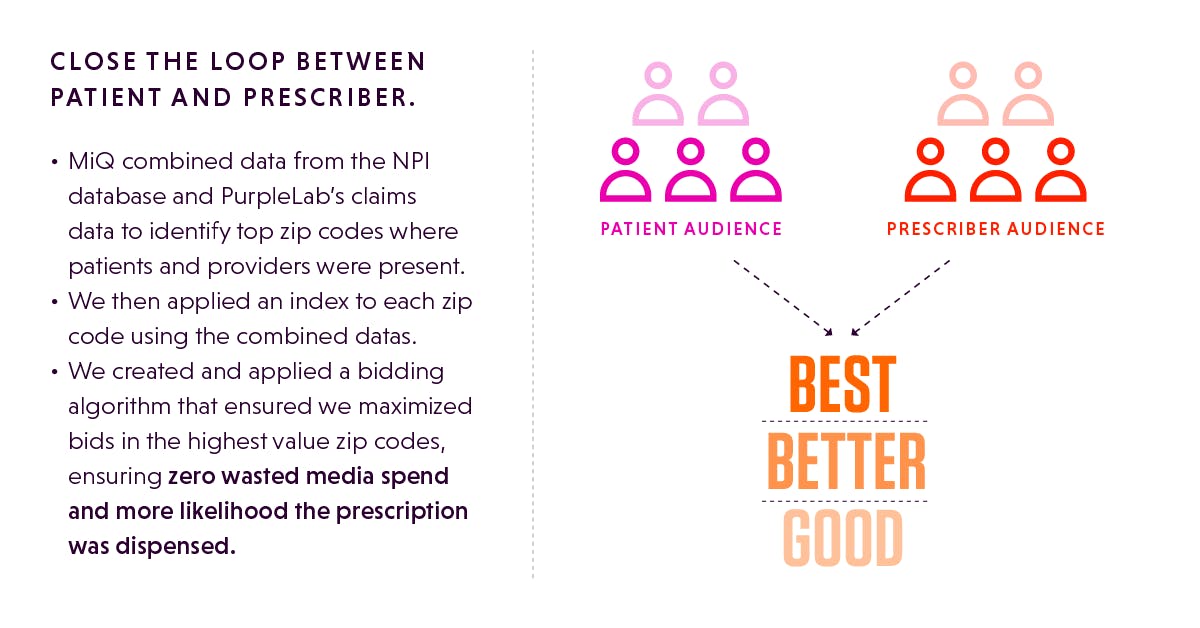
Aligning DTC and HCP marketing makes sense for pharma marketers–doctors are consumers too, and they are exposed to the same advertising as a brand’s DTC audience. They are equally important to the patient journey. The healthcare professional must understand the treatment or medication before recommending it, and the patient makes the final decision to act on the doctor’s recommendation or not. Aligning these two journeys, and these two strategies, empowers each to inform and optimize the other.
The traditional siloing of DTC and HCP pharma marketing leads to inefficiencies and wastage, especially in the HCP market. As a result, pharma brands have an uphill battle toward scaling their business. But, by including HCP in the patient funnel, marketers can align supply (eligible health care providers) with demand (patients seeking treatment), minimizing media wastage and maximizing prescription lift performance.
The benefits of DTC and HCP alignment
There are numerous benefits to creating a full-patient journey strategy that aligns DTC and HCP marketing at every step.
Less waste, more lift. Aligning eligible health care providers with patients seeking treatment enables pharma marketers to minimize media wastage and maximize prescription lift performance.
Smarter intelligence. The alignment of supply and demand in healthcare helps identify opportunities to more accurately direct media spend and pharma brand sales rep activity.
Better patient experiences. Connecting patients who suffer from a condition to healthcare providers who are able and willing to prescribe your brand helps ensure patients have accessible care.
In fact, using a multi-DSP approach, MiQ increased reach by 60% against a unique HCP list, while ensuring a 95% re-identification rate, meaning that 95% of campaign impressions were matched back to that list. You can learn more about our programmatic pharma offering here.
The challenges of aligning DTC and HCP marketing
For starters, pharma marketers operate in one of the most heavily regulated industries. Their audiences are niche and difficult to target, they are heavily regulated, and, most relevant here, DTC, HCP and OTC often are managed by siloed teams, creating competing priorities that make measuring success across objectives challenging. Both DTC and HCP have their own unique challenges as well, such as:
- Finding DTC audiences is challenged by poor and/or low scaled data.
- Offline metrics such as prescription filled or product purchased makes DTC measurement difficult.
- NPI and HCPs lists can be in the low-thousands, making scalability difficult.
- Poor modeling solutions in HCP cause issues with reaching the proper audience.
- Success requires the ability to tie digital ad exposure to dispensed prescriptions and doctor visits (offline metrics).
Challenges are not full-stops, however. They are opportunities for innovation and new solutions.
How to align DTC and HCP marketing strategies
Aligning supply (eligible health care providers) with demand (patients seeking treatment), enables pharma marketers to minimize waste, maximize performance, and create a better patient journey.
To close the loop between these two marketing strategies, marketers need to be able to pull and combine multiple types of data:
- NPI data
- Claims data
- Geographic data
- Media data (Where are these users? What are they reading/watching? When are they online?)
And then create a strategy that targets the areas, channels, and devices where their ideal patients and prescribers are present. That’s a monumental task involving multiple data partnerships, DSPs, and of course an in-house team well-versed in data science and programmatic activations. (Or you can work with a partner that does it all for you.)
At MiQ we built out two audiences–one from HCP data and one from patient claims data. We then overlapped the top zip codes from these audiences. We added one more layer of specificity by overlaying the types of content the two audiences read. From there, we were able to create a bidding strategy that ranked zip codes and/or contextual data in real-time. That ensured we were maximizing our bidding on areas where the doctor and patient might be, and when they were most likely to be interested in the treatment.

Now imagine the possibilities when other data, such as ACR or OTC purchase data are added. Your omnichannel programmatic campaign can target both the patient and prescriber audience at the right time, on the right screen, and with the right creative to move them toward the final outcome of a dispensed script.
Explore the top 3 challenges pharma marketers face in 2023, and how our data and partner agnostic approach can reveal the opportunity hidden within, by downloading our new report, 2023 Pharma Marketing Trends Report.



